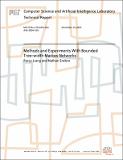Methods and Experiments With Bounded Tree-width Markov Networks
| dc.contributor.author | Liang, Percy | |
| dc.contributor.author | Srebro, Nathan | |
| dc.date.accessioned | 2005-12-22T02:19:52Z | |
| dc.date.available | 2005-12-22T02:19:52Z | |
| dc.date.issued | 2004-12-30 | |
| dc.identifier.other | MIT-CSAIL-TR-2004-081 | |
| dc.identifier.other | AIM-2004-030 | |
| dc.identifier.uri | http://hdl.handle.net/1721.1/30511 | |
| dc.description.abstract | Markov trees generalize naturally to bounded tree-width Markov networks, onwhich exact computations can still be done efficiently. However, learning themaximum likelihood Markov network with tree-width greater than 1 is NP-hard, sowe discuss a few algorithms for approximating the optimal Markov network. Wepresent a set of methods for training a density estimator. Each method isspecified by three arguments: tree-width, model scoring metric (maximumlikelihood or minimum description length), and model representation (using onejoint distribution or several class-conditional distributions). On thesemethods, we give empirical results on density estimation and classificationtasks and explore the implications of these arguments. | |
| dc.format.extent | 10 p. | |
| dc.format.extent | 10714507 bytes | |
| dc.format.extent | 473643 bytes | |
| dc.format.mimetype | application/postscript | |
| dc.format.mimetype | application/pdf | |
| dc.language.iso | en_US | |
| dc.relation.ispartofseries | Massachusetts Institute of Technology Computer Science and Artificial Intelligence Laboratory | |
| dc.subject | AI | |
| dc.subject | tree-width | |
| dc.subject | hypertrees | |
| dc.subject | Markov Networks | |
| dc.subject | maximum likelihood | |
| dc.subject | MDL | |
| dc.title | Methods and Experiments With Bounded Tree-width Markov Networks |
